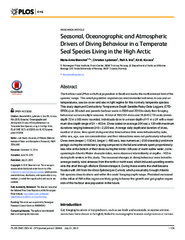Blar i forfatter "Blanchet, Marie-Anne Ermeline"
-
At-sea behaviour of the world's northernmost harbour seal (Phoca vitulina) population in a changing Arctic
Blanchet, Marie-Anne Ermeline (Doctoral thesis; Doktorgradsavhandling, 2016-04-15)The earth is experiencing warming at a rate that challenges the adaptive capacities of many animal species. Because marine mammals can integrate and reflect ecological variation across various spatial and temporal scales, they are prime sentinels of marine ecosystem change. This thesis explores movement patterns and foraging behaviour, and the ontogeny of these behaviours, in harbour seals (Phoca ... -
Harbour seal Phoca vitulina movement patterns in the high-Arctic archipelago of Svalbard, Norway
Blanchet, Marie-Anne Ermeline; Lydersen, Christian; Ims, Rolf Anker; Lowther, Andrew D.; Kovacs, Kit (Journal article; Tidsskriftartikkel; Peer reviewed, 2014-09-03)Harbour seals Phoca vitulina are mainly considered a temperate species, but the world’s northernmost population resides year-round in the high-Arctic archipelago of Svalbard. In this study we document post-moulting at-sea movements of 30 individuals from this population using satellite relay data loggers deployed in the autumns of 2009 and 2010. All of the seals showed a strong preference for ... -
Seasonal, oceanographic and atmospheric drivers of diving behaviour in a temperate seal species living in the high arctic
Blanchet, Marie-Anne Ermeline; Lydersen, Christian; Ims, Rolf Anker; Kovacs, Kit (Journal article; Tidsskriftartikkel; Peer reviewed, 2015-07-21)The harbour seal (Phoca vitulina) population in Svalbard marks the northernmost limit of the species’ range. This small population experiences environmental extremes in sea and air temperatures, sea ice cover and also in light regime for this normally temperate species. This study deployed Conductivity Temperature Depth Satellite Relay Data Loggers (CTDSRDLs) on 30 adult and juvenile harbour ...


 English
English norsk
norsk

